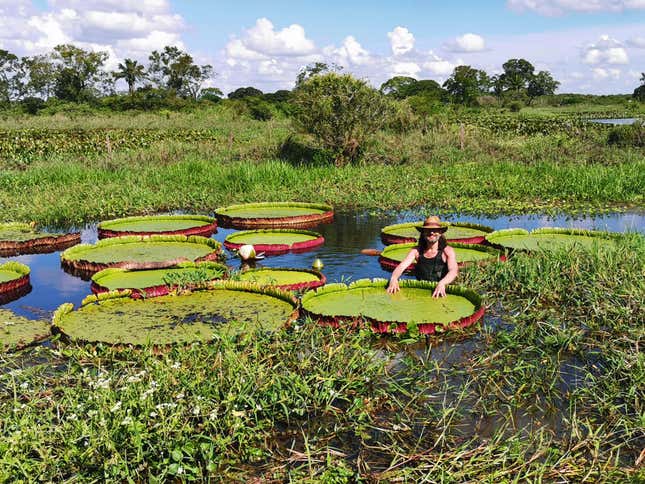
An international team of scientists has shown that two species of giant water lily are actually three, and that the newly discovered species, at 10.5 feet across, is the largest of the bunch.
Introducing Victoria boliviana, a newly described species of giant water lily. The freaky-looking plant joins two others in this South American genus, V. amazonica and V. cruziana. The newly described species of giant water lily is the first to be discovered in over a century, according to a Kew Gardens press release.
The genus, named for England’s Queen Victoria, was established during the early 19th century, but scientists originally thought they were dealing with a single species. This oversight was later corrected, resulting in the creation of two species, V. amazonica and V. cruziana. The new research, published in Frontiers in Plant Science, has now yielded a third Victoria species—and it’s a whopper. A specimen of V. boliviana from La Rinconada Gardens in Bolivia features a record-breaking diameter of 10.5 feet (3.2 meters), establishing it as the largest giant water lily species in the world.
Carlos Magdalena, a senior botanical horticulturist at Kew Gardens in England and a co-author of the new study, had suspected that a third species might exist. He noticed that certain specimens didn’t seem like either of the two known species, as they featured distinctive leaves, flowers, and seeds.
With these uncertainties in mind, Magdalena and his colleagues embarked on a study with the stated “goal of improving systematic knowledge of the [Victoria] genus,” as the scientists write in their study, and to make it happen they delved into history, horticulture, and geography, while also gathering “a morphological dataset using citizen science and specimens from herbaria and living collections,” they write.

The team, which also included botanists from the National Herbarium of Bolivia, studied samples obtained from Santa Cruz de La Sierra Botanic Garden and La Rinconada Gardens, both in Bolivia. They also grew seeds from the suspected third species, allowing for a side-by-side comparison with the other giant lilies.
A number of key differences were documented, including a unique distribution of prickles and seeds that were differently shaped and sized. DNA samples further showed that V. Boliviana was genetically distinct from the other two species, having distinctive molecular markers related to chloroplasts. Combined, the physical and genetic evidence allowed for the identification of the previously overlooked species.
The team also came to the realization that a specimen belonging to the newly described species had been stored at Kew Gardens since 1845. No one realized it represented a distinctive species, as it was previously mistaken for V. amazonica.
As for the plant itself, Victoria boliviana is native to Bolivia and is found in Llanos de Moxos in the Beni province—one of the world’s largest wetlands. It flowers on multiple occasions each year, but each flower opens one at a time and for just two nights, during which time its prickly flowers turn from white to pink. It’s a truly amazing and exotic sight, showing the incredible biological diversity that our planet has to offer, but more research is needed, as the scientists write: “Further investigations and surveys are required to better understand the species’ current range, population fluctuations and habitat and thus better predict the impacts of the threats identified.”
More: This Freaky Plant Has an Incredible Trick For Luring in Flies.